Comtrend PG-9172 Powerline Adapter Review: G.hn Gets Primed for Retail Push
by Ganesh T S on May 3, 2016 8:30 AM EST- Posted in
- Powerline Adapters
- Networking
- Marvell
- G.hn
- HomePlug
- Comtrend
HomePlug and G.hn Go Head to Head
This section presents the benchmark numbers obtained for the four different test cases outlined in the previous section. The Comtrend PG-9172 numbers are graphed in red, while the ZyXEL PLA5405 (representing HomePlug AV2 with MIMO support) numbers are in blue. The main tussle is between these two adapters - they are close in price (USD 77 vs. USD 83) and represent the best possible implementations of the two standards in the evaluated set.
Performance Metrics - TCP Downlink and Uplink
Node A represents the shortest physical distance between the tested nodes. This is a close fight between the HomePlug AV2 and G.hn adapters, with the PG-9172 coming out with a slight lead. Surprisingly, the ZyXEL PLA5206 SISO adapter is better than the PLA5405 in this scenario.
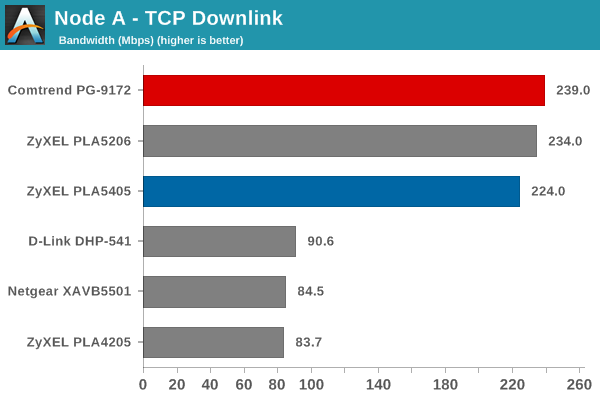
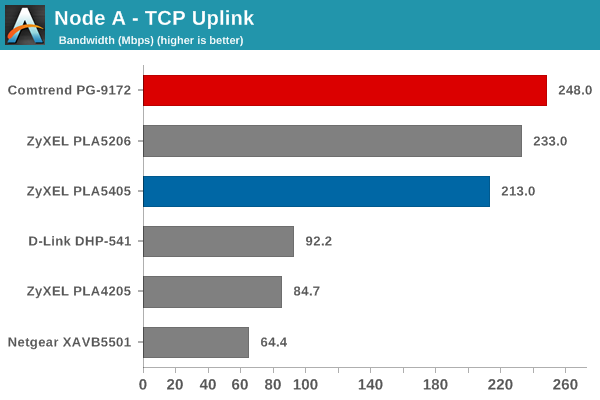
Node B is the garage outlet across the AFCI circuit breaker. The SISO adapter is the surprise winner here, though the G.hn PG-9172 comes a close second. The PLA5405 comes in third, quite a bit behind the G.hn adapter.
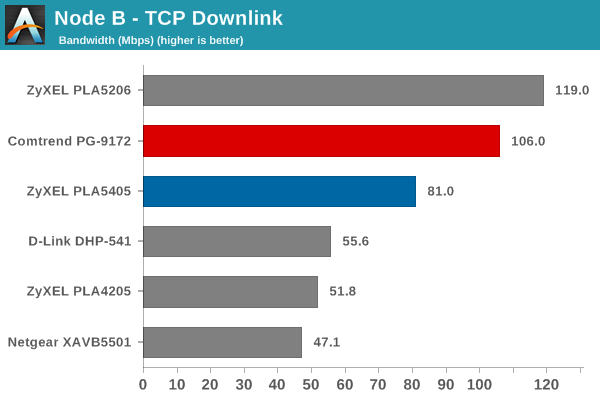

Node C is in the same wall as the garage outlet, and across the circuit breaker again. Here, the Comtrend adapter performs quite well, though it is really hard to choose between the HomePlug AV2 adapters and the G.hn adapter given the small differences in the bandwidth numbers.

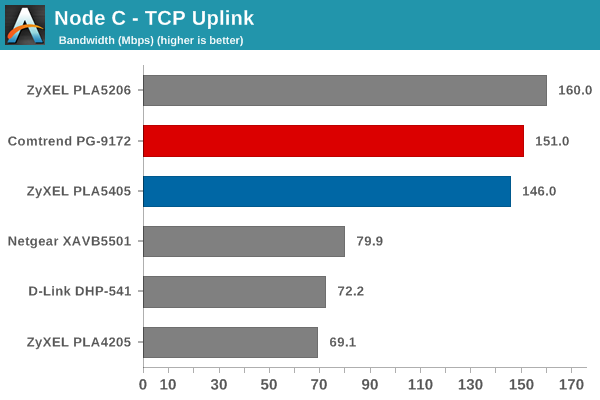
Node D is one of the farther outlets from the master node, and the Comtrend PG-9172 adapter establishes a clear and sizable lead over the HPAV2 adapters.
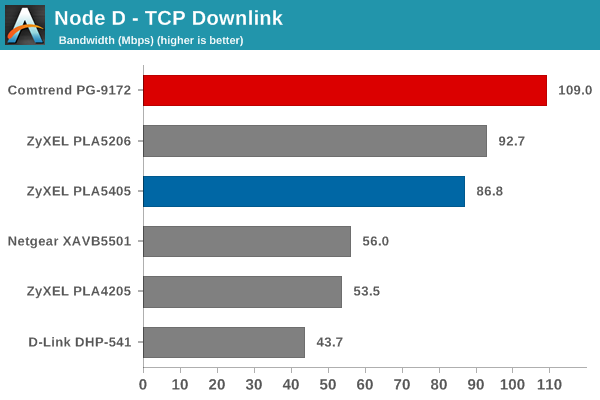
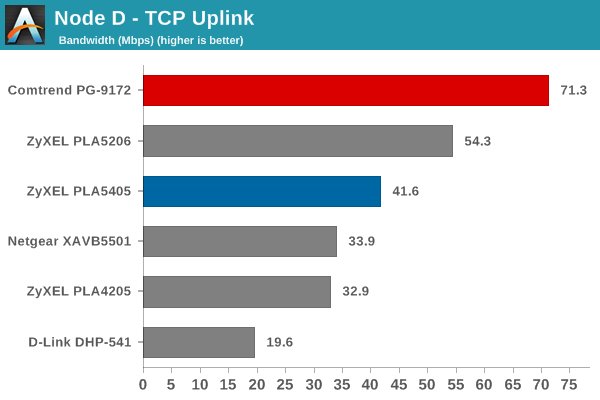
Node E is in the adjacent room, and is one of the closer adapters (similar to Node A). The performance ordering is also similar.
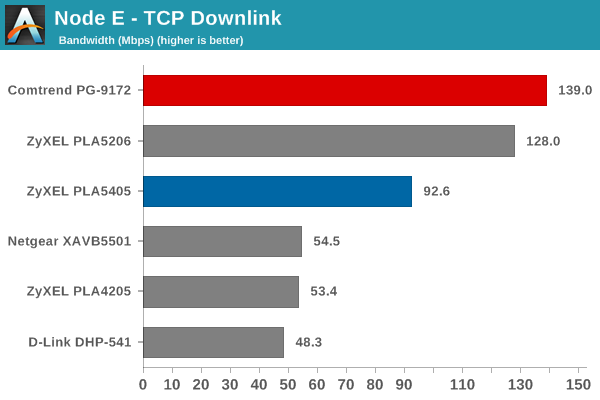

The Comtrend PG-9172 emerges as the clear winner in Node F.
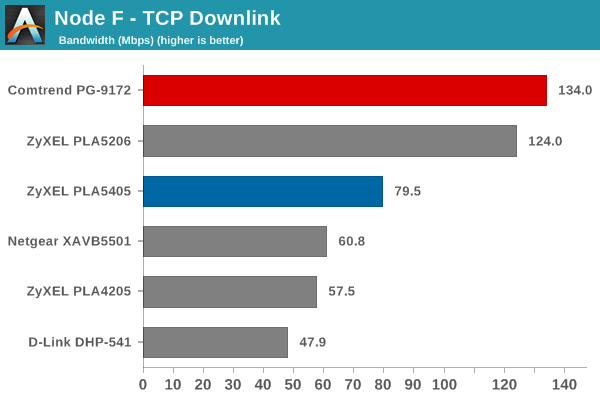
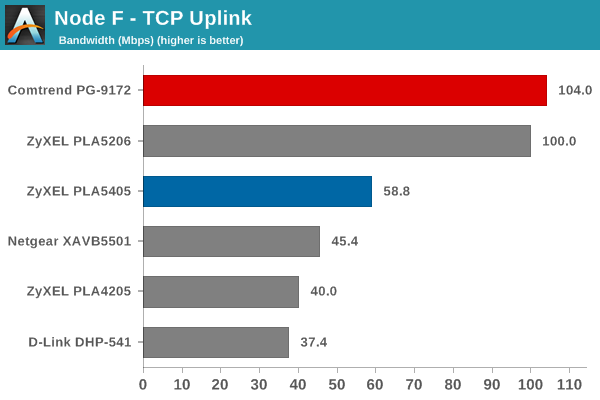
Performance Metrics - UDP Downlink and Uplink
The UDP results across all the nodes are similar in ordering to the TCP results.
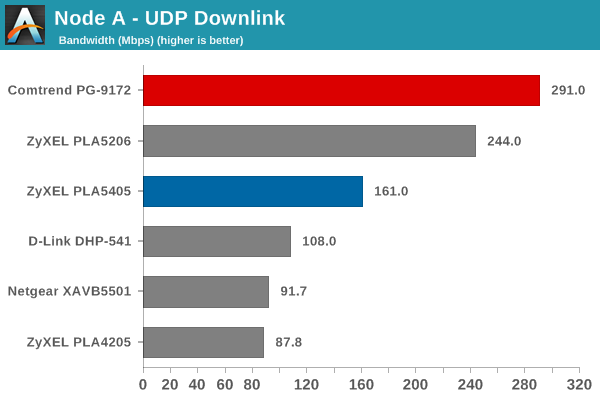
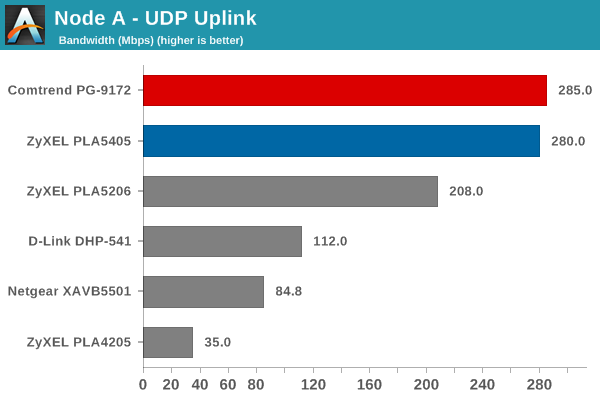
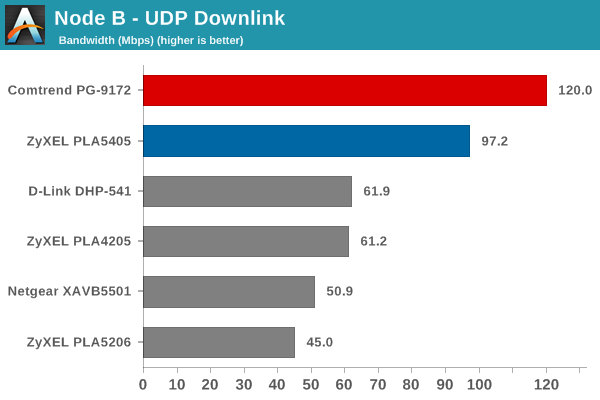
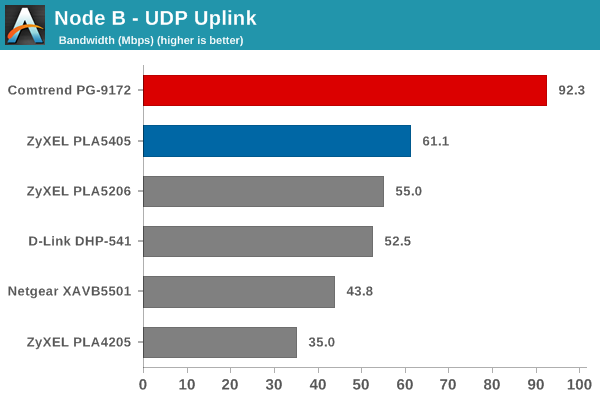
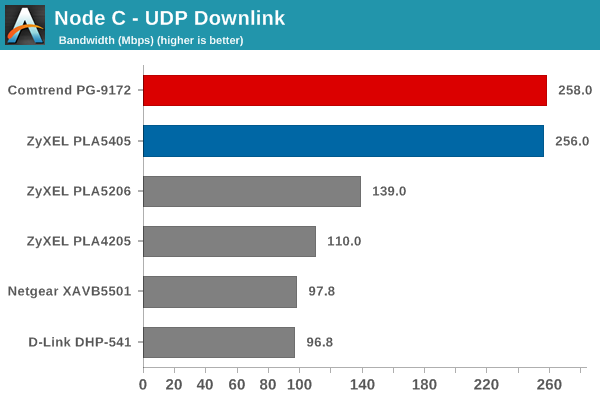
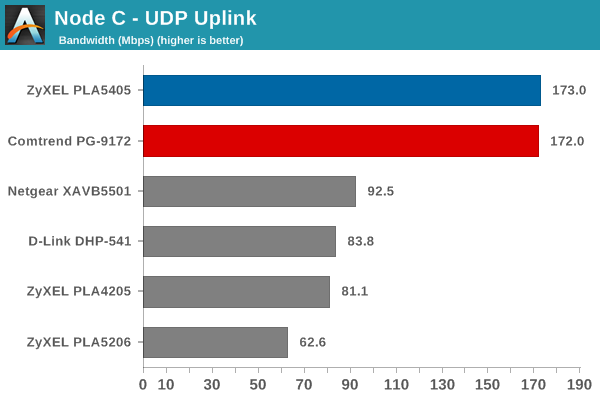
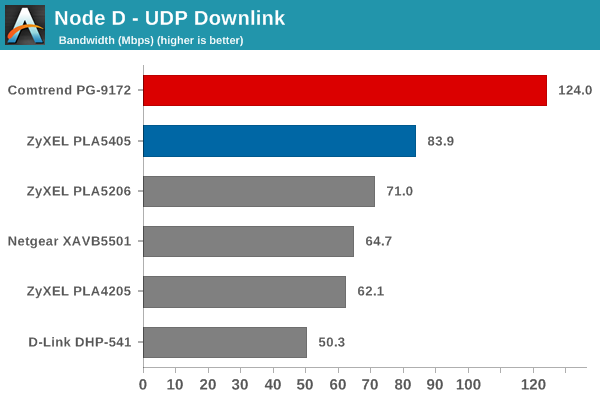
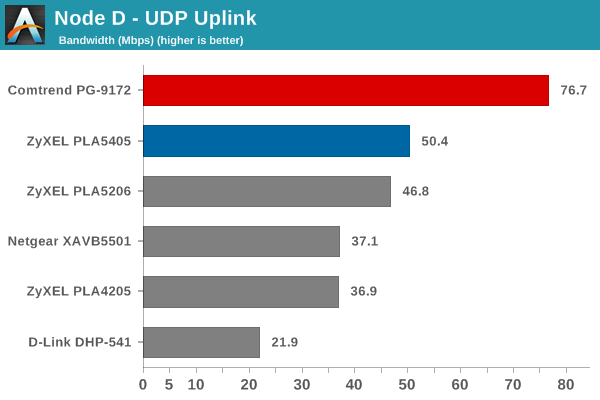

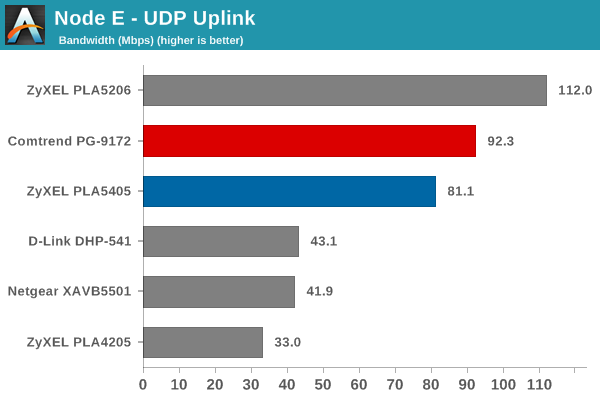
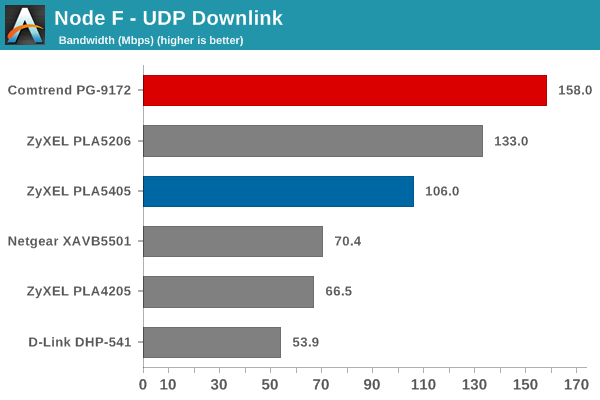
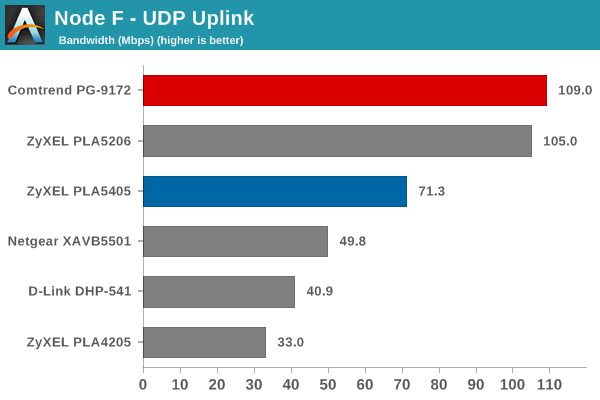
The above results show that the Comtrend PG-9172 G.hn adapter has the best performance in almost all of the tested scenarios.










48 Comments
View All Comments
kamm2 - Wednesday, May 4, 2016 - link
Yeah, 99.99% chance a home built in 1892 with good wiring does not have 1892 wiring. If it was even built with any wiring.extide - Wednesday, May 4, 2016 - link
While I agree with most of what you say, the words 'Occupancy' and 'Flipping' should never be used in the same sentence when talking about homes...kmmatney - Wednesday, May 4, 2016 - link
I would think it would just be easier to use wireless in an older home. With most people having laptops , phones, ipads, etc.. your going to be on wireless most of the time anyways. You can get repeaters easily enough. My home was built in 1999, with ethernet cables wired across the whole house, but it turns out a lot of the connections are not convenient, so I still use mostly wireless.I did use a powerline adapter for one connection, and found it was a bit finicky, and wouldn't work between all plugs (and I'm sure my wiring is fine).
mgrier - Tuesday, May 3, 2016 - link
Definitely. It would rock for a streaming box but I guess those tend to be small USB-powered and use wireless. I'd prefer to have a real outlet needed and avoid cluttering my wifi with video.Murloc - Thursday, May 5, 2016 - link
because the power network in houses is a mess or unknown to the owner and something always ends up not working.Wireless is just a better solution for most people and applications and even that isn't hassle-free.
fazalmajid - Tuesday, May 3, 2016 - link
I am getting spotty performance on a pair of PLA-5405 I use to bridge upper and lower floors in my 1936 house with electrical wiring upgraded in 2006 (odd layout makes Cat5/6unpractical, plaster and lath construction is highly effective at blocking WiFi). I ordered a pair of these and a pair of HomePlug AV2000 Extollo Lansocket 1500 that outperform them in other reviews. G.hn proponents claim it has better noise resistance, I'd like to put that to the test.Guspaz - Tuesday, May 3, 2016 - link
You seem to use the terms "HomeGrid" and "G.hn" interchangeably without ever explaining that they're the same thing. That was very confusing, as for most of the first page of the article, I thought you were talking about three different standards.Valantar - Tuesday, May 3, 2016 - link
I agree. It took me all of the first page to understand that G.hn and HomeGrid were the same thing. No clear link between the two names, and no mention in the introduction. What do the two names mean? Is one a standards organization, while the other is the name of their tech? If so, which is which? And why have two names at all?Guspaz - Tuesday, May 3, 2016 - link
I think adding a single word would solve the problem. Change this:However, despite silicon getting demonstrated at various trade shows, G.hn was unable to get a retail product out for a long time.
To this:
However, despite silicon getting demonstrated at various trade shows, HomeGrid's G.hn was unable to get a retail product out for a long time.
grazapin - Tuesday, May 3, 2016 - link
Yeah that first paragraph drops the names HomePlug, HomeGrid, G.hn and Comtrend with no explanation of how they relate to each other. I picked up most of it from context, but how G.hn fit in was not clear for most of the article. In fact, the only explanation that jumps out at me now is in the very last paragraph: "HomeGrid / G.hn"